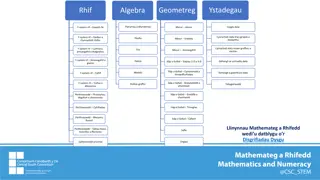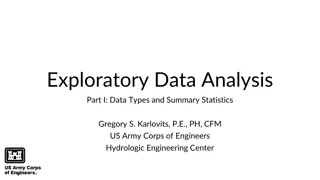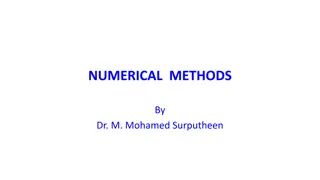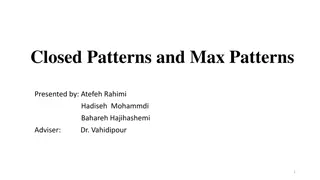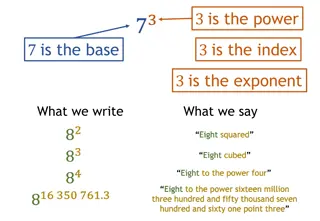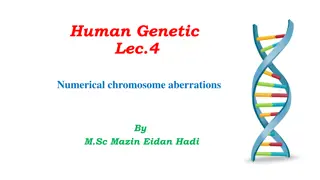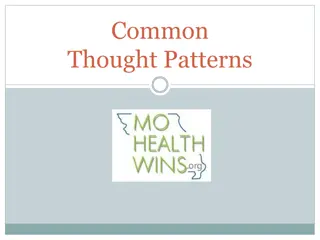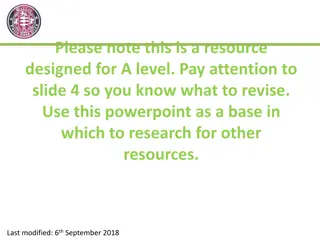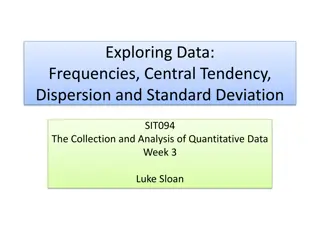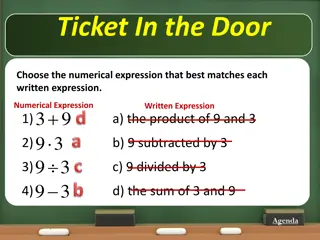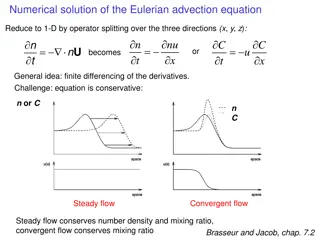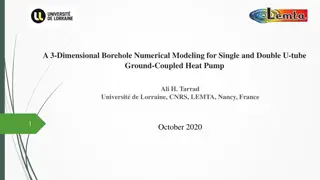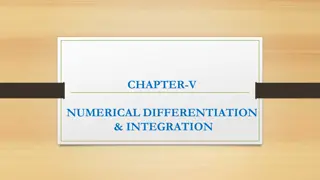And Applying Numerical Analysis in Statistics
Utilize numerical analysis techniques to interpret and manipulate numerical data effectively in various environments. Enhance your understanding of value placement in digital contexts to make informed decisions based on positioning and order. Develop skills in reading, writing, and interpreting numb
8 views • 36 slides
Data Types and Summary Statistics in Exploratory Data Analysis
Data types, including discrete numerical, continuous numerical, ordinal, and nominal, are essential in exploratory data analysis. Variables can be categorized based on their nature, such as numerical variables (interval vs. ratio) and categorical data summaries. Learn about USGS flow measurements, n
7 views • 48 slides
Numerical Methods and Errors in Computation
Delve into the world of numerical methods through the guidance of Dr. M. Mohamed Surputheen. Explore topics such as solving algebraic and transcendental equations, simultaneous linear algebraic equations, interpolation, numerical integration, and solving ordinary differential equations. Learn about
6 views • 130 slides
Closed Patterns and Max Patterns in Data Mining
Explore the concepts of closed patterns and max patterns in data mining, along with challenges and solutions. Learn how closed patterns compress frequent patterns while maintaining support information, and how max patterns provide a lossy compression. Discover the difference between closed patterns
3 views • 10 slides
Introduction to Numerical Methods: A Comprehensive Overview
Numerical methods play a crucial role in solving mathematical problems efficiently through arithmetic operations. This lecture by Dr. Nur Uddin covers the fundamental concepts of numerical methods, emphasizing their importance in engineering problem-solving with the use of modern digital computers.
6 views • 17 slides
Introduction to Numpy and Scipy: Numerical Computing in Python
Numpy and Scipy provide powerful MATLAB-like functionality in Python for fast numerical computations, high-level math functions, and efficient handling of multidimensional arrays. Learn why NumPy is essential for speeding up numerical computations in Python and explore key features such as arrays, m
3 views • 47 slides
Numerical Expressions and Exponents Overview
This content covers various numerical expressions involving exponents, including examples of valid and invalid mathematical representations, matching worded expressions with their numerical equivalents, and identifying the correct expressions based on provided criteria.
1 views • 30 slides
Numerical Chromosome Aberrations in Humans
Numerical chromosome aberrations involve the gain or loss of whole chromosomes, impacting the genome size and potentially leading to genetic mutations. Nondisjunction, where chromosomes fail to separate properly during cell division, can result in aneuploidy - the presence of an extra or missing chr
4 views • 18 slides
Common Thought Patterns in Communication
Common thought patterns in communication help structure messages effectively to increase understanding and engagement. Recognizing these patterns benefits readers by enhancing comprehension, engagement, recall, and writing skills. The five most common thought patterns are list, sequence, definition,
2 views • 16 slides
Introduction to Design Patterns: Understanding GOF Patterns
Explore the world of design patterns with a focus on Gang of Four (GOF) patterns. Understand the essence of design patterns, learn about GOF patterns, and discover how to select, apply, and use these patterns effectively. Dive into the fundamentals of design patterns, including creational and struct
9 views • 115 slides
Numerical Methods in Mathematics
Explore the world of numerical methods in mathematics, focusing on the Newton-Raphson Method and root approximations. Discover how to locate roots of equations and use iteration to enhance your problem-solving skills. Uncover the significance of numerical methods in finding solutions to complex equa
5 views • 28 slides
Overview of Numerical Methods in Computational Fluid Dynamics
This material delves into the properties, discretization methods, application in PDEs, grid considerations, linear equations solution, and more involved in Numerical Methods in Computational Fluid Dynamics. It covers approaches to fluid dynamical problems, components of numerical methods, and their
4 views • 40 slides
Numerical Study of Submerged Oil Leak Jet
This study focuses on a numerical investigation of a submerged turbulent oil jet, aiming to calculate the oil discharge rate despite the opaque nature of the oil. The research involves experimental test cases, CFD simulations, and analysis of large and small-scale structures in the oil-water interfa
2 views • 24 slides
Numerical Analysis of Aerodynamic Performances in Biplane Configuration
This paper presents a numerical investigation comparing single versus double wing (biplane) configurations for aerodynamic performances. Geometric models and numerical analyses were conducted, providing insights into the advantages and complexities of biplane wings. The study utilized computational
2 views • 12 slides
Quantitative Data Analysis in Research
Dive into the world of quantitative data analysis with a focus on frequencies, central tendency, dispersion, and standard deviation. Explore the collection and analysis of numerical data, levels of measurement, and methods for quantifying social concepts. Learn about the importance of capturing data
0 views • 25 slides
Math Expressions Exploration for Elementary Students
This content discusses numerical and algebraic expressions, teaching students how to match written expressions to numerical expressions, understand the concept of variables, and differentiate between algebraic and numerical expressions. It also covers basic operations like addition, subtraction, mul
2 views • 11 slides
Customising Numerical Models for Galactic Elemental Abundance Tracking
This study delves into customizing numerical models to track production of selected elemental species in a Milky Way-type galaxy. The GIZMO code by Hopkins (2015) offers versatile numerical methods, including cooling, star formation, and feedback mechanisms. The experiments focus on an isolated gala
2 views • 16 slides
Deriving numerical integration methods
Most numerical integration formulas involve a weighted average of the integrand values. One approach is to approximate the integrand with a polynomial, integrate it, and derive the integration formula. This method is demonstrated with examples such as the composite trapezoid rule and Simpson's rule.
2 views • 14 slides
Numerical Integration in Numerical Methods
This lecture covers the fundamentals of numerical integration, including upper and lower sums, trapezoid method, Romberg method, Gauss quadrature, definite and indefinite integrals, the fundamental theorem of calculus, and the area under the curve. The concepts are explained with examples and calcul
1 views • 53 slides
Numerical Patterns in Thousands, Tens, and Ones
Delve into the fascinating world of numerical patterns represented in thousands, tens, and ones. Explore the visual imagery reflecting the complexities and relationships between tens, hundreds, and millions. Uncover the intricate interplay of digits in this captivating journey of numbers and their s
4 views • 14 slides
MATH 2140 Numerical Methods
Dive into the world of numerical methods for mechanical engineering with a focus on numerical differentiation, finite difference formulas, differentiation formulas using Lagrange polynomials, curve fitting, Richardson's extrapolation, and more. Explore how these computational techniques enhance engi
3 views • 11 slides
Numerical Representation and Unsigned Integers
Fundamentals of binary number systems, unsigned integers, and positional number systems. Understand how numerical values are represented in computer science, the range of numbers they can express, and the rules for different numerical bases. Discover the significance of bits, binary digits, and lear
5 views • 25 slides
Numerical Solution of Eulerian Advection Equation in 1-D Operator Splitting
The Eulerian advection equation is solved numerically in 1-D by operator splitting over the x, y, and z directions. The process involves finite differencing of derivatives and ensuring conservation in steady and convergent flows. Different finite-difference approximations of derivatives are discusse
2 views • 13 slides
Numerical Solutions of ODEs in Engineering
This content discusses the practical application of numerical methods for solving Ordinary Differential Equations (ODEs) in engineering problems. Starting from physical laws, it covers the generation of differential equations, numerical and analytical solutions, and techniques for solving initial va
1 views • 11 slides
Fiscal Framework in Latvia: Hierarchy of Laws and Numerical Rules
Fiscal framework in Latvia is governed by a structured hierarchy of laws focusing on fiscal discipline and numerical rules to ensure financial stability and accountability. Key components include the Fiscal Discipline Law, Medium-Term Budget Framework, and Annual Budget Law. These laws outline regul
3 views • 27 slides
Numerical Weather Prediction in Atmospheric Sciences
Numerical Weather Prediction is a crucial method of weather forecasting that involves translating fluid flow equations into computer code, integrating them based on initial conditions and domain boundaries. This field, developed in the 20th century with advancements in computing, uses meteorological
1 views • 12 slides
Numerical Integration in Ship Geometry and Design
Explore how numerical integration methods such as Simpson's 1st Rule are applied in calculating important geometric properties of ships, including waterplane area, sectional area, submerged volume, and more. Learn the steps involved in using numerical calculation for precise results in ship design.
2 views • 28 slides
Numerical Methods for Differentiation and Integration
Explore the principles and techniques of numerical differentiation and integration in this comprehensive guide. Learn different methods like Taylor's series expansion and forward, backward, and centered differences to evaluate derivatives. Discover how to apply these numerical techniques to various
5 views • 38 slides
Borehole Numerical Modeling for Ground-Coupled Heat Pump
Explore a 3D numerical modeling study on single and double U-tube ground-coupled heat pump systems. Understand the orientation, models, case study, and dimensions. Analyze boundary conditions and numerical methods for efficient heat transfer.
1 views • 21 slides
Numerical Integration in Engineering and Science
Discover the importance of numerical integration in solving engineering and scientific problems, including applications in heat flow calculations and curve length measurements. Learn about the need for numerical integration, approaches involved, and the difference between closed and open integration
0 views • 18 slides
Math 448/548 Numerical Analysis Course Information
Explore the detailed course information for Math 448/548 Numerical Analysis, covering topics, assignments, evaluation criteria, and projects. Learn about MATLAB, textbook, instructor details, and more in this comprehensive overview. Prepare for quizzes and assignments while gaining insights into num
1 views • 20 slides
Numerical Differentiation and Integration: Basics and Methods
Understand the fundamentals of numerical differentiation and integration in calculus, essential for engineers dealing with changing systems. Learn about forward and central difference formulas, numerical integration techniques like the trapezoidal and Simpson's rules, and non-computer methods for di
2 views • 49 slides
Numerical Methods in Engineering Courses
Explore the importance and application of numerical methods in the field of engineering. Learn about solving mathematical problems efficiently using arithmetic operations and computer programming. Grasp the fundamentals of numerical analysis and its significance in engineering and scientific endeavo
3 views • 32 slides
Introduction to Numerical Methods and Nonlinear Equations
Explore the fundamental problems of numerical analysis with a focus on solving nonlinear equations using iterative numerical methods. Learn about different types of nonlinear equations and how to formulate them for numerical solutions.
3 views • 49 slides
Efficient Numerical Integration Methods Overview
Explore various numerical integration techniques including Richardson extrapolation, Bulirsch-Stoer method, Rosenbrock method, and more. Understand the caveats, approaches, and error control mechanisms for efficient computation. Dive into practical examples and step-by-step processes for implementin
0 views • 12 slides
Understanding Numerical Differentiation and Integration Techniques
Explore the concepts of numerical differentiation and integration, including forward and backward difference formulas, interpolating polynomials, and error considerations. Learn how to compute derivatives and integrate functions using numerical methods. Dive into the intricacies of solving for deriv
4 views • 53 slides
Mechanical Engineering Department Numerical Methods Course Overview
Explore the curriculum of MATH 2140 Numerical Methods course in the Mechanical Engineering Department, covering topics like nonlinear equations, linear systems, numerical differentiations, integrations, and more, taught by Dr. Phillips Agboola. Assessment tasks and required text are also included.
0 views • 21 slides
Numerical Integration Methods in Geometric Calculations
Learn about the importance of numerical integration in complex geometric calculations for ships, including the application of Simpson's 1st rule. Discover how to calculate waterplane area, sectional area, submerged volume, and more using numerical integration techniques.
3 views • 28 slides
Introduction to Numerical Methods and Applications
Explore the fundamental concepts of numerical methods, including Taylor series, algorithms for obtaining numerical solutions, basic requirements, and techniques for solving nonlinear equations and linear systems. Dive into topics such as interpolation, numerical integration, and differential equatio
0 views • 73 slides
Numerical Treatment of Orthogonality Condition Model
Explore the numerical treatment of the orthogonality condition model in few-body systems, focusing on anti-symmetrization among fermions and the importance of the Orthogonality Condition Model (OCM) in solving few-body problems within allowed functional spaces. Simplifications and transformations of
1 views • 9 slides
